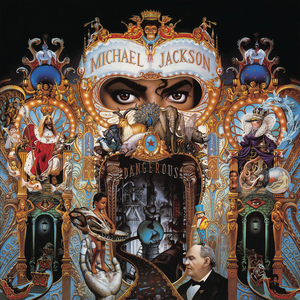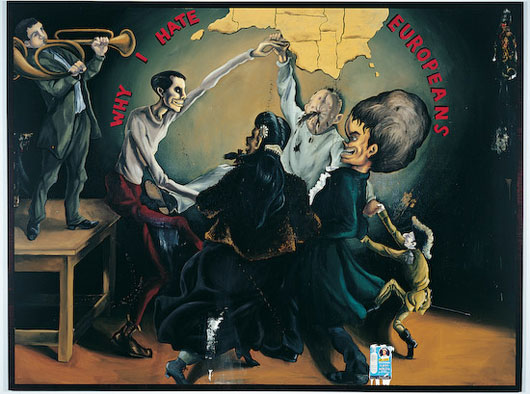Post Modern Exhibit
For my Post Modern exhibit this week, I decided to focus on the “Lowbrow” style of art that emerged during this period–otherwise known as “Pop Surrealism.” This type of art is characterized by its qualities that made it a significant rebellion against what has always been considered “Fine Art” up to that point in history. These works were (and are) often fueled by a form of passionate anarchy and presented a new idea of what art should be–which was completely born from the twisted perceptions of these artists.

Mark Ryden– born January 20, 1963– was a pop artist that created pieces of art that were inspired by objects that evoke mystery. Among his many paintings, he also contributed to the music world by using his talents to create album art for many artists including Aerosmith, Red Hot Chili Peppers, and Michael Jackson. Pictured above would be “Album Cover Art for Michael Jackson’s Dangerous” created in November 1991. This is an incredibly busy piece that is simply loaded with many symbols from Michael Jackson’s life. I really enjoy this piece because of its many intricate layers. Every time that I look at this piece, I see something new and it gain more–and deeper–meaning.
 The next piece I chose for the exhibit would be from Filipino pop-artist Manuel Ocampo–born 1965. The piece is entitled “Why I Hate Europeans” and it was created in 1992. Ocampo is famous for his dark, Gothic style of painting in order to tell a beautiful story–and make powerful expressions. This piece is rather bizarre to me in its grotesqueness, yet I still can’t help but be compelled by it. This piece, coincidentally enough, was also used as album cover art for the band Skinny Puppy’s 2007 album “Mythmaker.”
The next piece I chose for the exhibit would be from Filipino pop-artist Manuel Ocampo–born 1965. The piece is entitled “Why I Hate Europeans” and it was created in 1992. Ocampo is famous for his dark, Gothic style of painting in order to tell a beautiful story–and make powerful expressions. This piece is rather bizarre to me in its grotesqueness, yet I still can’t help but be compelled by it. This piece, coincidentally enough, was also used as album cover art for the band Skinny Puppy’s 2007 album “Mythmaker.”

Another interesting artist that contributed to the pop-surrealist movement would be Lisa Yuskavage. A highly educated artists from Philadelphia, Yuskavage uses rich vibrant and earthy colors to portray avant-garde perceptions of reality as in the above pictured piece, “Scarecrow” (2012). Many of Yuskavage’s works contain nudity and bizarrely proportioned views of the male and female form (larger and smaller than average genitalia, for example). In doing so, I feel that she speaks volumes as to how much these body parts mean to her individual subjects. What truly drew me to her artwork, however, was her captivating use of color, and her uniquely cartoon-y view of her subjects.
Takashi Murakami is another artist that brought Pop-Surrealism to the mainstream with his current art exhibits the world over. The The Japanese artist (born February 1962) has proven himself to be among the most prolific artist of our time, according to Juxtapoz Magazine. In this piece, entitled “Open Your Hands, Embrace Happiness!” (2010), the viewer cannot help but feel the happiness that the artist conveys. Within the greater exhibit, it is actually portrayed ironically–however, I really enjoy this piece for the effective way that it makes me feel as a viewer. The artist has a particular way he wants me to feel, and I certainly feel that way–in this case, happiness.

Inka Essenhigh is another very highly educated artist born in 1969 from Pennsylvania. She currently works in New York and produces very dramatic paintings. Inka Essenhigh’s piece entitled “Green Wave” (2002), is yet another powerful piece that conveys both violence and heaviness. This piece of pop-surrealism is captivating to me through the artist’s use of the beautiful teal-green color. I also really enjoy the way that the artist creates almost “tentacles” from the wave to keep the subject “tied” down to the water’s surface. This gives the sea in the painting a subtle quagmire-like quality.

Nicola Verlato is an Italian-American artist hailing from the Los Angeles, CA area. He currently produces works that are very similar to those that were found in the Italian Renaissance. Oftentimes, Verlato’s works will have religious undertones or fantastic, science-fiction qualities. What I like most about many of his paintings is the fact that they capture such movement. Some of his works–as in the above pictured “David” (September 2013)– capture car accidents in the middle of the incident. The subjects of these paintings are in awkward positions, with limbs akimbo, and flying through the air–but suspended in time and space at the same time. I adore these pieces because they capture such drama, fear, and action.
Works Cited:
Susanta. “MEANING OF THE MICHAEL JACKSON’S DANGEROUS ALBUM COVER- Bogus Blogging.” SUSANTA. N.p., 08 Nov. 2009. Web. 16 Nov. 2015. <http://susanta.com/meaning-of-the-michael-jacksons-dangerous-album/>.
“A Fistful of Soundtracks: The Blog: Filipino American History Month Painting of the Day: “Why I Hate Europeans” by Manuel Ocampo.” A Fistful of Soundtracks: The Blog: Filipino American History Month Painting of the Day: “Why I Hate Europeans” by Manuel Ocampo. N.p., n.d. Web. 16 Nov. 2015. <http://afistfulofsoundtracks.blogspot.com/2011/10/filipino-american-history-month_10.html>.
“Bio.” Lisa Yuskavage. N.p., n.d. Web. 16 Nov. 2015. <http://yuskavage.com/bio/?m=bio_link>.
“Open Your Hands Wide, Embrace Happiness by Takashi Murakami | Paddle8.” Paddle8: Open Your Hands Wide, Embrace Happiness. N.p., n.d. Web. 16 Nov. 2015. <https://paddle8.com/work/takashi-murakami/37776-open-your-hands-wide-embrace-happiness>.
“Inka Essenhigh.” 303 Gallery –. N.p., n.d. Web. 16 Nov. 2015. <http://www.303gallery.com/exhibition/index.php?iid=10640&exhid=61&p=img>.
Seed, John. “Nicola Verlato: “Pagan Pop” at Merry Karnowsky Gallery.” The Huffington Post. TheHuffingtonPost.com, n.d. Web. 16 Nov. 2015. <http://www.huffingtonpost.com/john-seed/nicola-verlato_b_3944662.html>.





